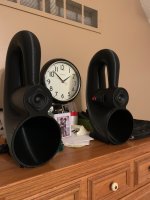I think this author is misinterpreting Peter Fryer's work. I was involved in the listening tests and this is certainly NOT what we found.The results were intriguing. Distortion of the flute was gross at 10mm peak diaphragm displacement and not in the least bit euphonic. On the contrary, Doppler made the sound as harsh as you might expect of a distortion mechanism that introduces intermodulation products. At 3.16mm peak displacement (below Fryer's suggested detectability threshold) the distortion level was obviously lower but still clearly audible; and even at 1mm it could still be heard affecting the flute's timbre and adding "edge."
I can't seem to find the AES paper in AES library. Have they blocked off non-members?
AM, FM, PM, and now horn-induced modulation.... For a desktop say 1m distance, 1mm excursion, 100hz, 8" cone (200cm2), I think (math...) you'll only get 87.5dB direct sound from the cone; 50hz, only 75.5dB. Even 15" cone 1mm excursion 42hz (barely acceptable for acoustic instruments) pushes out just 86.5dB (math...), hardly loud enough for the opening prelude forget climax. So... all the audible low-ish bass come from resonances: BR, TL/QW, or horn. The cone is saved.Posting the link about Intermodulation-distortion because I think it affects coaxials and full-ranges in the computer desktop a lot more than room speakers with separate drives.
Last edited:
Instead of expecting a low distorition direct sound, why don't reduce the resonances modes in the medium range with small cones, exploit the resonances in the lows with medium cones in an optimized directivity enclosure... and stay away from the centralized sub configuration that destroy all le LF effects of the modern POP/EM music ?
"Desktop omni 23L 1.5m ~57.5hz quarterwave (heard and computed)"
In the table and wall soundfield or in an anechoic chamber ?
In the table and wall soundfield or in an anechoic chamber ?
See last page pics; for bass listening distance 0-1ft from exit. I finger tone-sweep very slowly in an Android APP called Frequency Sound Generator.In the table and wall soundfield or in an anechoic chamber ?
How about 3d printed mini BLH with 2 inch driver, maybe too big for desktop. Just a suggestion.Dear Gurus! Suppose I should not spend on the MonAcoustic SuperMon Mini (because it's kinda expensive) and instead I want to build something in the same category/class myself: the ultimate passive desktop monitor for audiophile classical/instrumental/acoustics playing at low volume with high fidelity.
Am I crazy or this is possible? Also, sorry for a new thread. Fill free to call me names, I deserve it.
- No bass is necessary, 65 Hz - 20 kHz
- Insane details, soundstage
- Classical/acoustic/instrumental/indie rock. I don't care how heavy metal sounds. No pipe organs. No movies, no games, only music. I hope to crack those symphony orchestras, finally
- Low volume, firing directly at me at 2 ft distance. Practically headphones
- Not huge, should fit on the table around computer monitor, but can be deep. I can always pull the table away from the wall
- Perhaps sealed, because it should be easier to build
- Drivers about $200 each, could be a bit more if absolutely necessary
- Perhaps full range, because I guess it's much easier?
- I should not regret that I don't have Supermon Minis
Attachments
Re-reading the above-quoted, compromise original spec (2.5 months later after trials), I'm optimistic for a desktop omni MAOP10 short tri-fold tapered ~1m TL (near native look of the stainless-sandwich trashcan), with extra-large egg-goatee reflector, listened-to omni but at downward non-constant angle. Necessarily compromised in FR off-axis uniformity, top/bottom extension, and soundstage depth -- when compared to the best possible non-desktop -- but good enough.
Here is another proof that IMD and Doppler distortions are caused by excessive cone movements. Here Amir is trashing the GR research little giant killer 2 for horrible distortions. However the speaker sounded much better when high passed at 80 Hz sharp. I don't think there is anything wrong with LGK 3" driver, it's just physics. I don't know what is the proper value for larger drivers but all 3 and 4" drivers must be high passed at 80 Hz, or if you want just 1st order filter 100 Hz.
Not sure the blarney over Doppler & IMD is relevant for a desktop speaker as they will usually have small bass units. Indeed, small bass unit size has little to do with sound quality so I would just try to find an ex-BBC LS 3/5a or one of the last KEF versions.
If you have a little more desk space, the JBL Paragon will only overhang a large desk slightly. 😊 It's really the first of the stereo bars.
No problems with Doppler or IMD
If you have a little more desk space, the JBL Paragon will only overhang a large desk slightly. 😊 It's really the first of the stereo bars.
No problems with Doppler or IMD
I'd say more important than a lot of things is some at least mild eq to tame any big peaks in your room. Once you flatten things up a bit it really does make all the difference in terms of how detailed it sounds and even improves the soundstage. I have sealed pluvia 7.2HDs with a sub for desktop use, not sure I would use them without a sub in the sealed configuration, but they do sound really good in my setup (regardless of price), so they do get a recommendation from me
SP1457 100mm 4ohm
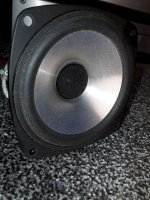
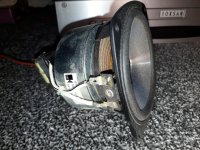
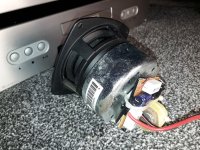
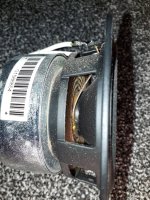
I have relocated the crossover there myself.
This is the right driver. The black tweeter is the visual clue. The v.2 is silver. Comparatively no magnet on the back of the silver tweeter one. Which aligns with the Q series, not the R series. These early one's have the internal port tube made of reinforced pvc vacuum hose, cable tied on. It's a diy look. The mass production version it's blow moulded or something. The v.2 is trash. A different speaker, pretending to be the v1 which got reviewed.




I have relocated the crossover there myself.
This is the right driver. The black tweeter is the visual clue. The v.2 is silver. Comparatively no magnet on the back of the silver tweeter one. Which aligns with the Q series, not the R series. These early one's have the internal port tube made of reinforced pvc vacuum hose, cable tied on. It's a diy look. The mass production version it's blow moulded or something. The v.2 is trash. A different speaker, pretending to be the v1 which got reviewed.
Please show us your DIY of $8000 system. I heard these in real life in what has got to be the smallest audio store ever in NYC. It was inside the shopping center at the bottom end of Central Park and was essentially a glass booth about the size of a small van fitted with a big screen TV and a bunch of these speakers. The acoustics were closer to the inside of a car with all the hard reflectors. It played loud but any car stereo will be loud because inside a sealed box. I am curious what a proper DIY implementation would be. But two side firing high excursion woofers and a front firing midrange and dome tweeter coax are a good start.
I have a limited experience with speakers, ~zero experience with speaker building but I have a lot of experience with distortions. All mainstream speakers I ever owned or heard had a lot of audible distortions, all distortion free high end speakers I heard are not suitable for computer desktop.
Suppose aliens come to Earth and decided to use their alien superpowers to make traditional cone-based desktop speakers. They won't be able to make full range speakers because that's against the laws of physics (links above). The small full range will have distortions that are impossible to avoid. The large full range could be distortion free but they will be beaming in the face and won't play much beyond 10 kHz.
In the 2-driver path aliens won't be able to cross in the 1-3 kHz range because that's where human voice is and human should sound whole. So they must cross either at 150-900 Hz or above 3 kHz.
Crossing at 150-200 the woofers are omni and can be separate, somewhere at the table or beneath. 200-900 woofers must be at least 6" or will be distorted by the laws of physics as above. 6" or so should be behind full range for imaging. 8" and above should be up-firing with reflector, which is also the full range housing. 8" cannot fire in the face, this will be beaming and have edge diffractions. 6" won't have enough efficiency for up-firing, if played at high volume we are back to the distortions problem.
Crossing at 3k+ means a small tweeter instead of full range. Still either 6" coaxial position or 8"+ up-firing with tweeter in the middle.
Suppose aliens come to Earth and decided to use their alien superpowers to make traditional cone-based desktop speakers. They won't be able to make full range speakers because that's against the laws of physics (links above). The small full range will have distortions that are impossible to avoid. The large full range could be distortion free but they will be beaming in the face and won't play much beyond 10 kHz.
In the 2-driver path aliens won't be able to cross in the 1-3 kHz range because that's where human voice is and human should sound whole. So they must cross either at 150-900 Hz or above 3 kHz.
Crossing at 150-200 the woofers are omni and can be separate, somewhere at the table or beneath. 200-900 woofers must be at least 6" or will be distorted by the laws of physics as above. 6" or so should be behind full range for imaging. 8" and above should be up-firing with reflector, which is also the full range housing. 8" cannot fire in the face, this will be beaming and have edge diffractions. 6" won't have enough efficiency for up-firing, if played at high volume we are back to the distortions problem.
Crossing at 3k+ means a small tweeter instead of full range. Still either 6" coaxial position or 8"+ up-firing with tweeter in the middle.
In just a year or two I made a couple dozen minimalist near-fields, and I could probably live with most of them, as proxies for the live music that I miss. Each and every driver I use is special in some ways, and good enough elsewhere -- regardless of cost. The speakers are coherent and articulate. None of them (near-fields) are common-place multi-way on front-baffle bass-reflex. However, used as desktop none will have wide-enough horizontal and vertical unattenuated dispersion, to cover seamlessly every likely position and posture 6DF, with flat response to 10khz and enough extension above (say ~15khz).
Just. Do. It. Yourself.
PrimeRadiant convex-reflector point-source could do it. Open-wing headphones with crossfeed, delay, and EQ could do it. And possibly, omni with the right phase-plug-like reflector matched to the driver response/dispersion could do it. (This last thingy is no harder to make than a nested set of concentric tubes or a roll of wound-up nonadhesive tape; optimize on-the-fly.)
Just. Do. It. Yourself.
PrimeRadiant convex-reflector point-source could do it. Open-wing headphones with crossfeed, delay, and EQ could do it. And possibly, omni with the right phase-plug-like reflector matched to the driver response/dispersion could do it. (This last thingy is no harder to make than a nested set of concentric tubes or a roll of wound-up nonadhesive tape; optimize on-the-fly.)
Last edited:
if you look carefully at your w6-2313, you will see that the tweeter is fixed, so no doppler effect on this kind of coax.Posting the link about Intermodulation-distortion because I think it affects coaxials and full-ranges in the computer desktop a lot more than room speakers with separate drives.
Are those the Devialet?I heard these in real life.
If so, possibly the worst speaker I have ever heard. Medium sized room, medium levels. It was screeching, distorting and one note bass. Just horrible, selling only on design and marketing, probably only to those who just liked the looks and never heard it in real life.
I agree! The woofer is still the waveguide for the twitter reflections and it's a moving waveguide, but as the primary source is fixed it is probably not audible at normal volumes.if you look carefully at your w6-2313, you will see that the tweeter is fixed, so no doppler effect on this kind of coax.
As explained here the primary source of the IMD is the mechanical one - the cone is incapable to react on high frequency voltage changes when it is away from the neutral position. The coaxials are immune to this for the tweeter range, only below crossing. This is full range problem.
Yes Devialet. I wasn’t impressed with the sound quality. But it’s hard for a lot of commercial speakers to sound as good as the best of DIY speakers.Are those the Devialet?
If so, possibly the worst speaker I have ever heard. Medium sized room, medium levels. It was screeching, distorting and one note bass. Just horrible, selling only on design and marketing, probably only to those who just liked the looks and never heard it in real life.
- Home
- Loudspeakers
- Full Range
- How to build the best possible audiophile desktop?
